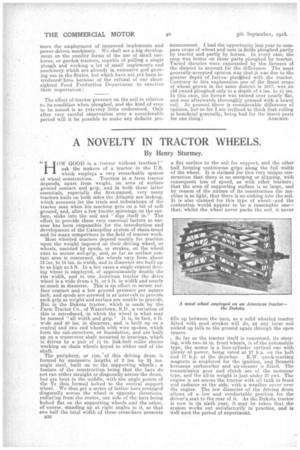A NOVELTY IN TRACTOR WHEELS.
Page 18

If you've noticed an error in this article please click here to report it so we can fix it.
By Henry Sturmey.
11.6
. OW GOOD is a tractor without traction'? "
ask the makers of a tractor in the U.S.
which employs a very remarkable system of wheel construction. Traction in a farm tractor depends, apart from weight, on area of surface ground contact and grip, and in both these latter essentials, especially the first-named, very many tractors built on both sides the Atlantic are lacking, which accounts for the trials and tribulations of the tractor man when his machine gets on a bit of soft ground, and, after a few frantic spinnings on the surface, sinks into the soil and " digs itself in." The effort to provide these very essential factors to success has -been responsible for the introduction and development of the Caterpillar system of chain-tread and its many competitors in the field of tractor work.
Most wheeled tractors depend mainly for traction upon the weight imposed on their driving wheel, or wheels, assisted by spuds, or strakcs, on the wheel rims to secure soil-grip, and, so far as surface contact area is concerned, the wheels vary from about 12 ins. to 15 ins. in width, and in diameter are built up to as high as 5 ft. In a few cases a single central driving wheel is employed, of approximately double the rim width, and in one American tractor the drive wheel is a wide drum 4 ft. or 5 ft. in width and nearly as much in diameter. This is an effort to secure surface contact and a low ground pressure per square inch, and spuds are screwed in at intervals to provide such grip as weight and surface are unable to provide. But in the Dakota, tractor, which is made by the Farm Tractor Co., of Watertown, S.D. a variation of this is introduced, in which the wheel is what may be termed "all width and grip." It is, in fact, 5 ft. wide and 40 ins, in diameter, and is built up on a central and two end wheels with wire spokes, which form the sub-structure, or foundation, and are built up on a transverse shaft mounted in bearings, which is driven by a pair of ii in. link-belt roller chains working on chain wheels keyed to either end of the shaft.
The periphery, or rim, of this driving drum is formed by successive lengths of 2 ins. by 21 angle steel, built on to the supporting wheels ; a feature of the construction being that the bars do not run either straight or diagonally across the drum, but are bent in the middle, with the angle points of the Ts thus formed bolted to the central support wheel. We thus get a series of lattice bars arranged diagonally across the wheel in opposite directions, radiating from the centre, one side of the bars being bolted flat on the supporting wheels and the other, of course, standing up at right angles to it, so that one half the total width of these cross-bars presents B38 a flat surface to the soil for support, and the other half forming continuous grips along the full width of the wheel. it is claimed for this very unique construction that there is no creeping or slipping, with consequent loss of speed, as with other tractors ; that the area of supporting surface is so large, and by reason of the nature of its construction the machine is so light, that there is no sinking into the soil. It is also claimed for this type of wheel—and the contention would appear to be a reasonable one— that, whilst the wheel never packs the soil, it never
fills up between the bars, as a solid wheeled tractor fitted with mud strakes will dial as any loose soil picked up falls to the ground again through the open spaces.
. So far as the tractor itself is concerned, its steering, with two 34 in. front wheels, is of the automobile type, the motor is a four-cylinder vertical one with plenty of power, being rated at 27 -h.p. on the belt and 17 h.p. at the drawbar. K.W. quick-starting i magneto s employed for the ignition, and Bennett kerosene carburetter and air-cleaner is fitted. The transmission gear and clutch are of the motorcar type, and the all-in weight is just under 37 cwt. The engine is set across the tractor with oil tank in front and radiator at the side, with a weather cover over the engine. The low diameter of the driving drum allows of a low and comfortable position for the driveekseat to the rear of it. As the Dakota tractor is now in its sixth year, it may be taken that the system works out satisfactorily in practice, and is well mist the period of experiment.






















